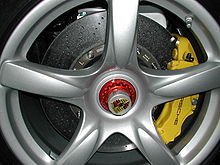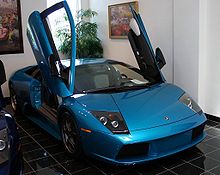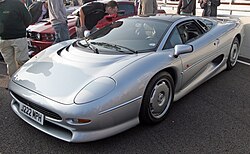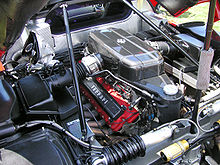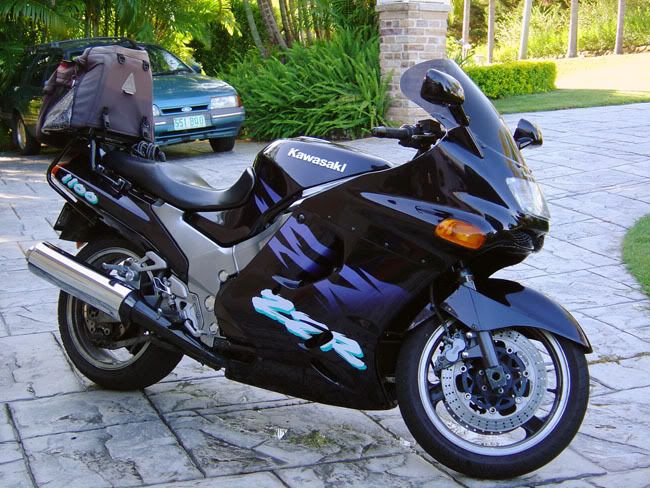Koenigsegg CCX
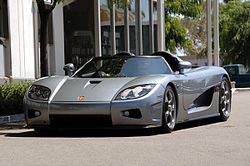 |
| Manufacturer | Koenigsegg |
| Production | 2006–present |
| Predecessor | Koenigsegg CCR |
| Successor | Koenigsegg CCXR |
| Class | Sports car |
| Body style | 2-door roadster |
| Layout | Rear mid-engine, rear-wheel drive |
| Engine | 4.7 L twin-supercharged V8 |
| Transmission | 6-speed manual |
| Wheelbase | 2,660 mm (104.7 in) |
| Length | 4,293 mm (169.0 in) |
| Width | 1,996 mm (78.6 in) |
| Height | 1,120 mm (44.1 in) |
| Curb weight | 1,180 kg (2,601 lb) |
| Designer | Sven-Harry Åkesson |
|
The
Koenigsegg CCX is a mid-engined roadster from Swedish car manufacturer Koenigsegg. The CCX has been engineered to comply with the U.S. regulation and market demands
and is a newer design that replaced the Koenigsegg CCR.
CCX is an abbreviation for
Competition Coupé X; the X commemorating the 10th anniversary (being the Roman numeral for ten) of the completion and test drive of the first CC vehicle in 1996.
The CCX was first unveiled on February 28, 2006 at the 2006 Geneva Motor Show although its existence was announced earlier.
A derivative known as the CCXR is available, the main difference being that CCXR's engine is tuned to run on biofuel. The different fuel and tune allows the CCXR to produce 25% more power than the CCX.
Development
Koenigsegg began the CCX project with the aim of entering the world market, though particularly the United States car market.
Development engineer Magnus Jaasund said "We wanted to go into the world market, but we couldn’t do it with the old car.
To sell cars to the North American market many alterations were made to the design of the CCR; the previously used Ford Modular engine was replaced by a Koenigsegg engine designed to run on 91 octane fuel, readily available in the United States, and to meet the Californian emission standards.
The front bumper of the CCX is designed to be safer in low speed collisions than previous Koenigseggs and the whole body is 3.46 in (88 millimeters) longer to comply with the United States' rear impact regulations. Additionally the CCX can display United States or European number plates.
The CCX is 1.6 in (40.6 mm) taller than the CCR and, combined with the carbon fiber reinforced plastic sports seats by Sparco, the CCX allows for 2 in (50.8 mm) of extra headroom that
Autoweek reviewer Mark Vaughn hypothesizes is "to accommodate U.S. NBA stars.
The electronic control unit has also received an upgrade over the CCR meaning that the CCX is without physical fuses and it is lighter than the previous system.
Specifications
Performance
The CCX can accelerate from 0–62 mph (100 km/h) in 3.2 seconds and from 0–124 mph (200 km/h) in 9.8 seconds. According to Koenigsegg it has a top speed of approximately 250 mph (400 km/h), although this has not been officially verified. On 15 June 2008, a standard fully equipped CCX was independently timed by sport auto in achieving a record 0-186-0 mph (0-300–0 km/h) in 29.2 seconds, beating the Mercedes-Benz McLaren SLR 722 Edition, the Lamborghini Murciélago LP640, the Porsche 997 GT2, the Alpina B6 S (based on the BMW 6 Series), and the Corvette Z06.
Engine

The engine of a Koenigsegg CCX at the 2006 Geneva Motor Show
Previous Koenigsegg models were powered by Ford Modular V8 engines sourced from the U.S. Though also based on the Ford Modular architecture the engine of the CCX was thoroughly re-engineered by Koenigsegg themselves and is assembled at the Koenigsegg factory.
The engine block for the dual overhead camshaft, 4 valve per cylinder 4.7 liter 288 cu in (4,719 cc) V8
is cast for them by Grainger & Worrall, a British company that produces drivetrain components for Formula One cars.
The engine block is made of 356 Aluminium that has undergone a T7 heat treatment, a form of accelerated precipitation strengthening.
The aluminium alloy is stronger than the previous engine and allows a thinner, thus lighter, engine block that will withstand higher cylinder pressures. The engine is boosted by two centrifugal superchargers that provide 17.5 psi (1.2 bar) of boost with an 8.2:1 compression ratio. The engine produces 806 bhp (601 kW; 817 PS) at 6900 rpm and 678 lb·ft (919 N·m) of torque at 5700 rpm on 91 octane (U.S. rating) gasoline.
The engine is lubricated with a dry sump system with a separate oil pump, the pistons are cooled by oil sprayed onto them and the oil itself has an external cooler.
The CCX does 14 mpg (17 l/100 km) in combined cycle and 18 mpg (13 l/100 km) in highway travel.
Exterior

A CCX at the 2006 SEMA car show in Las Vegas
The CCX is a two-door targa top and the removable roof can be stored under the front trunk meaning that, unlike many of its competitors, it can be changed at any location, not only one where the roof can be safely left.
The body, made of pre-impregnated carbon fiber and Kevlar, is 169 in (4,300 mm) long, 78.6 in (2,000 mm) wide and 44.1 in (1,120 mm) tall with a ground clearance of 3.9 in (99 mm).
As with all previous Koenigsegg models, the "dihedral synchro-helix" actuation doors rotate forward and upwards similar to scissor doors though the Koenigsegg design avoids the problem of the open door obscuring the passenger's entry or exit.
The CCX has a frontal area of 2,894 sq in (1.867 m
2) and a drag coefficient of just 0.30. It also has a flat underside with venturi tunnels at the rear and an optional rear spoiler to improve aerodynamics.
Between the 2 speedster humps (humps behind the seats) is a vortex generator used as a ram-air intake that allows higher pressure in the air box without a roof scoop that would increase the frontal area. At 124 mph (200 km/h)

The standard magnesium-alloy rear wheel of a CCX
The standard CCX wheels are Koenigsegg's magnesium alloy wheels, though the option to upgrade to carbon/magnesium wheels which each weigh 6.6 pounds (3.0 kg) less than the standard wheels is available.
The front wheels have a diameter of 19 inches (480 mm) and the rear, 20 inches (510 mm). Each of the wheels is attached by center locking wheel nuts.
The car comes with Michelin
Pilot Sport 2 unidirectional tires with asymmetric tread. The front tires have codes of 255/35 Y19 and the rear 335/30 Y20.
The front and rear cast iron disc brakes are 14.3 in (360 mm) across with 1.3 inches (33 mm) of contact at any point and have 6 piston calipers. The brakes can be upgraded to SystemST carbon ceramic brakes which weigh 4.4 pounds (2.0 kg) less per wheel, a diameter of 15 in (380 mm) with 1.3 in (33 mm) of contact and eight piston brake calipers.
Top Gear
In 2007, the CCX was the fastest car to complete a lap of the BBC
Top Gear circuit, in a time of 1:17.6 on the Power Lap, until it was beaten by the Ascari A10 with a time of 1:17.3.
The car originally lapped the circuit in 1:20.4, but was then fitted with a non-standard rear spoiler (Subsequently referred to in the CCX's and the Agera's option list as the 'Top Gear Wing') to provide downforce after the show's test driver (The Stig) spun the original version off the track. The Stig purportedly recommended this modification, predicting that the car would then be the fastest ever round
Top Gear's track
but Koenigsegg later stated that the improvement was due to adjustments to the chassis and suspension settings and not the addition of the rear spoiler.
CCXR
Koenigsegg CCXR

One of six Koenigsegg CCXR Edition at the 2008 Geneva Motorshow.
The
CCXR is an "environmentally-friendly" version of the CCX, powered by a modified twin-supercharged V8 engine from the CCX, converted to use E85 or E100 ethanol fuel as well as standard 98 octane petrol.
When run on regular petrol, the CCXR develops 806 bhp (601 kW), but when the car is run on E85 Biofuel, the CCXR develops 1,018 bhp (759 kW). Weight-to-power ratio is 2.76 lb/hp. Torque is 782 ft·lb (1,060 N·m). The CCXR can achieve 62 mph (100 km/h) in 2.9 seconds. Christian von Koenigsegg is quoted as saying,
"Our engineers couldn't quite believe the figures when we tested the car".
The increased power is a result of the cooling properties of ethanol in the engine's combustion chambers allowing for a higher pressure in the cylinder and the biofuel having a higher octane rating of 113 RON compared to 95 RON for gasoline in North America and 100 RON for gasoline in Europe.
The increase in octane rating allows greater spark advance before detonation occurs. Due to the lower energy content of ethanol the CCXR burns slightly more fuel than the CCX with about 15 mpg (17L/100 km).The only changes to the engine are modified fuel injectors, upgraded fuel lines and piston rings and a higher boost setting on the superchargers.
CCGT
Koenigsegg CCGT
 |
| Manufacturer | Koenigsegg |
| Production | 2007 |
| Class | GT1 |
| Body style | Racecar |
| Engine | 5.0 naturally-aspirated DOHC 32-valve V8
600 hp (441 kW) |
| Transmission | 6-speed sequential |
| Designer | Sven-Harry Åkesson |
The Koenigsegg CCGT is a one-off racing car built by Koenigsegg. Making its début appearance at the 2007 Geneva Motor Show, the CCGT is designed to compete in the grand tourer categories of sportscar racing.
Mechanically, the CCGT is very similar to the CCX. However, the most noticeable difference between the CCGT and the CCX is the engine - in order to meet the regulations for the GT1 class as set by both the ACO and the FIA, the two centrifugal superchargers were removed from the DOHC V8 engine. Its capacity was also increased from 4.7 litres to 5.0 litres to partially compensate for the loss of power resulting from the removal of the two superchargers. The power output is an air restricted 600 horsepower (591 bhp).
Through the extensive use of carbon fibre in the car's chassis and bodywork, the CCGT's weight is just 1,000 kg, allowing Koenigsegg's racing teams to use up to 100 kg of ballast freely to make the car meet the 1,100 kg minimum weight requirement for cars in its category.
Just after the cars development, the FIA changed the GT1 regulations so that there had to be a minimum of 350 road cars produced per year of the model that was to compete. As Koenigsegg's annual production volume was much less than this, they were unable to enter the car into GT racing. The CCGT has been driven at closed circuit sessions and events such as the Goodwood Festival of Speed but never entered into any racing series.
Koenigsegg have yet to announce any future participation in GT racing.
Edition
In March 2008, two models (the CCX Edition and the CCXR Edition) were launched at the Geneva Motor Show.
Both models are fitted with a remapped, 4.8 liter twin-supercharged Koenigsegg engine. The engine tune in the CCXR Edition is more powerful than that of the standard CCX, developing 1,018 bhp (759 kW) at 7000 rpm and 797 ft·lb (1,081 N·m) of torque at 5600 rpm. The CCX Edition develops 888 bhp (662 kW) at 7000 rpm and 679 ft·lb (921 N·m) of torque at 5800 rpm. In total the Edition produces over 772 lb (350 kg) of downforce at 155 mph (249 km/h).
The Edition CCXR and CCX are more track oriented compared to the standard models, being equipped with stiffer springs and anti-roll bars, reset dampers and a lowered chassis. The Edition CCXR and the CCX also feature a fully visible carbon body, a large adjustable rear wing, larger front splitter and side strakes and a unique forged wheel design.
The interior is also reworked and features: color matched leather carpets, Koenigsegg Edition side step plates, Edition chronograph instrument cluster, a new Edition only layout for the center console control panels, and features a special version of the Koenigsegg Chronocluster including a redesigned center console. All other extra equipment for the Koenigsegg Edition CCXR and CCX comes as standard: carbon wheels, special interior trim and color, rearview camera, Satnav or Bluetooth, amplifiers, complete Inconell exhaust system.
On March 19, 2009, Koenigesegg announced, via the Cars' UK
site, that production of the CCXR Edition will be limited to just four cars, and that of the CCX Edition to only two. This was partly in response to the decline in the world economy, but also because Koenigsegg are now committed to a environmentally responsible future, as demonstrated by the Koenigsegg Quant, which was shown at the Geneva Motor Show in 2009.Both models are fitted with a remapped, 4.8 litre twin-supercharged Koenigsegg engine, and have been track-tuned by the inclusion of modified shock absorbers, stiffer springs and anti-roll bars, reset dampers and a lowered chassis.

























